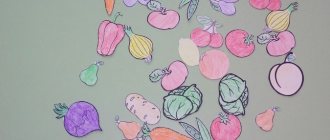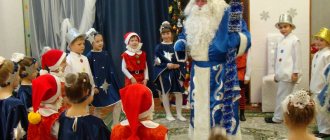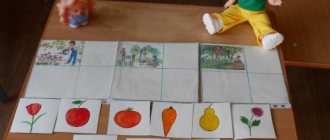Objectives of the game and preparation of didactic material
The locomotive for the game is a flat image made of cardboard, each car of which is painted in a certain color from the main palette. Transparent cells are attached to the carriages, into which game material is inserted. Various thematic images are used as material: numbers, geometric shapes, pictures of animals and plants, objects, transport and other things.
During the game, the train can be placed on a horizontal surface. Or you can hang it on a magnetic board - this is a more convenient and ergonomic option, allowing you to start playing at any time. If the train is attached to the board, the pictures should also have magnetic attachments. The number of trailers can be any, depending on what games the teacher plans to play with the students. The minimum quantity is 3 cars. But it’s better to do more, and then use all the trailers or only part of them for games.
The goals of the game are the diversified development of preschool children, including those with mental and speech disabilities.
The objectives of games with a train:
- expanding ideas about the world around us;
- strengthening cognitive interest;
- improvement of speech and thinking abilities;
- developing the skill of classification and ordering of objects;
- expanding mathematical knowledge, gaining the skill of counting, determining quantities;
- consolidation of ideas about geometric shapes and primary colors;
- development of fine motor skills, memory, perseverance, concentration.
For children of different age groups, you can come up with all kinds of games with a train.
Didactic manual “The Cheerful Little Train”
Research by scientists has proven that the number of preschool children with speech development disorders is currently increasing. Changes in indicators occur both in quantitative and qualitative terms: every year speech defects become more complex.
When entering preschool speech centers, children with delayed speech development sometimes require long-term speech therapy.
Often speech therapists, especially beginners, are in dire need of didactic and gaming aids, since repeated repetitions of the same material tire not only the child, but also the adult. And there is no escape from repetition, especially at the stage of audio automation, which can drag on for several months. And then the speech therapist has to figure out how and how to diversify the classes so that the material being worked on does not bore the child and is interesting for him. After all, only positive motivation will contribute to effective work, which will subsequently lead to the desired result.
It is also very important not to overload the child with a variety of games and benefits. Since the attention of preschoolers is involuntary, and children are often distracted, it is necessary to think through each aid in terms of versatility, so that when working, the child gets used to any aid, but does not lose interest in working with it.
Recently, more and more visual aids for classes with preschoolers have been produced. Unfortunately, not all children's educational institutions have the opportunity to purchase them. Speech therapists independently produce teaching aids using available material and imagination.
I consider “The Jolly Engine” to be one of the manuals that can help in speech therapy work. This manual can be used both in individual and in subgroup lessons with children of different age categories.
Goal: Using visual aids, increase the effectiveness of speech therapy, generate interest in classes, and create positive motivation in children.
The manual is multifunctional, its use depends on the tasks of the speech therapist in a particular lesson.
The train is permanently mounted on the wall, which saves office space and allows you to use it at any time. The train is made from isolon. The windows of the cars are made of metal plates covered with colored film. The locomotive window has a pocket for assignment. There are also pockets on the roofs of the trailers where you can place secondary tasks when the games become more difficult.
To work, you will need pictures and small toys (both are attached with magnets). When playing games, you can use one trailer, or two, or all three.
Options for games for children of older preschool age.
Cheerful family.
Purpose of the game: teach children to classify objects.
Picture material: pictures with animals, insects, flowers, birds, vegetables, etc.
Progress of the game: The speech therapist invites children to help place pictures in the carriages so that in one carriage there are pictures from one “family”, in the second – from another, and in the third – from a third
Find the brothers (the game uses two trailers)
Goal: To teach children to differentiate sounds.
Picture material: pictures with differentiated sounds.
Progress of the game: on the roofs of the trailers there are pictures indicating sounds (from the manual by Z.E. Agranovich “To help speech therapists and parents. Collection of homework.”). Children need to find brothers among the pictures that have the given sounds, and place them in the appropriate trailer (for example, in one trailer there are brothers whose names contain the sound [s], and in the other - the sound [s'])
Find the place of the sound in the word.
Goal: To learn to determine the place of a given sound in a word (beginning, middle, end), based on loud pronunciation.
Picture material: pictures with a given sound at the beginning, middle and end of a word.
Progress of the game: On the roof of the trailer there is a diagram of three squares: in the first trailer the first square is filled in, in the second - the second, in the third - the third. Children need to place the pictures in the corresponding trailers. If the given sound is at the beginning of the word, then the picture is placed in the first car, etc.
Conductor.
Goal: To teach children to determine the number of syllables in a word.
Picture material: pictures with different syllable structures.
Progress of the game: On the roof of the trailer there are diagrams indicating one syllable, two syllables, three syllables. The speech therapist invites the child to become a conductor and help passengers place them in the carriages in accordance with their tickets. To do this, you need to count the number of syllables in a word and place the pictures in the corresponding cars.
Match the pictures to the diagram.
Goal: To teach how to determine the place of a sound in a word (beginning, middle, end) by representation.
Picture material: pictures for diagrams.
Progress of the game: There are diagrams on the roofs of the trailers (for example, a diagram on the first trailer of three squares, colored blue, red, green; in the second trailer, a diagram of three squares - blue, red, blue; in the third trailer, a diagram of four squares - blue, red, blue, red). Children are asked to identify the passengers who will travel in each trailer.
Impact trailer.
Goal: To teach children to identify the stressed sound when pronouncing a word.
How to play: On the roofs of the trailers there are diagrams of words with emphasis on the first, second and third syllables. The speech therapist asks the children to determine which syllable the stress falls on, and in accordance with this, place passengers in the carriages
Make up a word.
Goal: Learn to identify the first sound in a word by presentation.
Progress of the game: The speech therapist places pictures in the trailers in advance, from the first sounds of which you can make a word. Children must guess the passenger of the trailer by identifying the first sounds in the names of the pictures (For example, in the first trailer there are pictures: shower, wasps, soap. This means the trailer is transporting a house, etc.)
Sound players.
Goal: To teach children to characterize the sound in a word.
Picture material: pictures indicating sounds (from the manual Z. E. Agranovich “To help speech therapists and parents. Collection of homework.”).
How to play: Blue, green and red squares are placed on the roofs of the trailers. The child takes a picture - a sound (sound), gives a description of this sound and places it in the appropriate trailer
Passengers.
Goal: automation of the sound being processed.
Progress of the game: The speech therapist places the pictures in the trailers in advance. Children are asked to name the passengers
Hares.
Goal: To learn to determine the presence of a given sound in a word.
Progress of the game: On the roofs of the trailers there are pictures indicating sounds. The speech therapist places passengers in carriages with a given sound, but one picture does not have a given sound. The child must turn into a controller and find the “hare”, i.e. extra picture.
Here is a small list of games that can be used in speech therapy work. The book “The Cheerful Little Engine” may be of interest not only to young specialists, but also to experienced speech therapists.
In older preschool age, children love to play with sounds. Any game can be adapted to this guide and children can be taught to play it.
Train and carriages
The game, which reinforces counting skills, is intended for preschoolers aged 4–6 years.
The teacher places images of numbers from 1 to 10 in the carriage cells, then asks the children to attach the carriages to each other in the correct order.
Didactic math game for preschoolers 3-6 years old
Didactic game for preschoolers “Mathematical Engine”
Author: Natalya Evgenievna Khokhlova Position: teacher-defectologist, MKDOU No. 18 (branch), Miass, Chelyabinsk region Name of resource: didactic game “Mathematical Engine” Brief description of the resource: game for preschool children on formation of elementary mathematical concepts, development of logical thinking. The purpose and objectives of the resource: strengthening counting skills, number composition, number series, ordinal counting; development of visual perception, logical thinking. Relevance and significance of the resource: the game can be used by speech therapists, defectologists, and parents in correctional work with children. Equipment: the game is made using a PC (personal computer), consists of planar images: a steam locomotive, trailers, wheels for trailers. Practical application: individual lessons, frontal correction lessons (as a demonstration of a task or a direct game “one at a time”). Method of working with the resource: 1. Individually: the child takes one of the trains.
A number is depicted on the wheel of the locomotive, the child places a trailer next to it and matches the wheels with numbers or dots to the trailer so that in pairs they make up the indicated number. 2. Front: used to demonstrate a task using a magnetic board and magnets; Children in their seats work orally and frontally. This game is aimed at strengthening counting skills and number composition. Option I
Place a train with several carriages in front of the child (the number of carriages depends on the child’s mastery of counting limits) and offer to number the carriages in order. For numbering, you can use any cards with numbers or use wheels from trailers.
For example, a train within 3
Then invite the child to count the total number of trailers, or count them in order, thus strengthening the ordinal count. Or, as an option to reinforce ordinal counting, invite your child to line up the trains with the numbers depicted on them in order.
Option II
Offer your child one of the trains with a certain number. Ask to prepare it for a long trip. But for this he needs to attach trailers. We don't know how many there will be. Therefore, we begin to attach one trailer at a time and select wheels for the trailer so that a pair of wheels together makes up the number depicted on the train. Carriages:
Wheels:
You can use wheels with dots or numbers. For example, the following trains can turn out:
You can invite your child to count how many trailers the locomotive will carry. Come up with other tasks using this material. I wish you creative success!
We recommend watching:
Passport for the senior group math corner Mathematical game in kindergarten for preschoolers with learning difficulties Do-it-yourself didactic game for preschoolers 4-6 years old according to FEMP Mathematical games for preschoolers 3-5 years old in kindergarten
Similar articles:
Math tasks in pictures for children 6-7 years old
Exercises with counting sticks for preschoolers
Teaching mathematics using the Nikitin method
Math problems jokes for preschoolers
Mathematical riddles for preschoolers in verse with answers
Didactic game "Merry little engine"
This game for preschoolers aged 5–6 years also improves counting skills and develops thinking abilities and spatial orientation.
The teacher asks the children to connect the cars, insert cards with numbers into the cells in the correct order. Students, having completed the task, list the numbers, first in direct order, then in reverse. Next, the teacher calls a number, the children find the corresponding trailer, name the adjacent numbers on the right and left sides.
Didactic game for speech development “Fun Train”
Nadezhda Belikova
Didactic game for speech development “Fun Train”
This year, at the city methodological association of secondary groups, it was decided to address the problem of the development of coherent speech in children of the fifth year of life.
According to E.I. Tikheyeva “... Coherent speech reflects the logic of the child’s thinking, his ability to comprehend what he perceives and express it in correct, clear, logical speech . By the way a child knows how to construct his statement, one can judge the level of his speech development ."
Consequently, the leading task is the development of coherent speech . Solving other problems is aimed at improving coherent speech , i.e. it is the level of its formation that acts as the main indicator of the level of general speech development of the child .
This topic is now becoming more and more relevant, as more and more non-speaking children come to the kindergarten. Gadgets are replacing live communication in the family. Bright pictures, moving characters with slurred, distorted speech, often not in their native language, become the child’s constant companions. Young parents themselves are passionate about “shooting games”; they want to chat with friends. But all this communication is virtual. It seems that they are both at home and with the child, but far from him, each in their own world.
Patterns of verbal communication disappear from a child’s life. After all, first of all, the child reacts to the voice of the mother, a loved one, this is an example to follow. What should I imitate? Monosyllabic phrases, slang expressions? Hence the paucity of speech , and consequently a decrease in the child’s intelligence.
Therefore, first of all, we need to “talk” to the child. L. S. Vygotsky wrote: “In mastering speech, the child goes from part to whole: from a word to a combination of two or three words, then to a simple phrase, even later to complex sentences... The final stage is coherent speech, consisting of a series detailed proposals ." And games help us with this. We can find a lot of games for speech development
I want to present my game, which I called “ Fun Train ”
This is a multifunctional game that can be used from the 2nd junior group until graduation. It all depends on what to fill it with. From the names of objects to the composition of words.
Game objectives:
To form in children methods of mental action (analysis, synthesis, comparison, generalization, classification, analogy)
To form learning motivation focused on satisfying cognitive interests.
To develop in preschoolers speech , the ability to express and justify their judgments.
Cultivate interest in educational activities and the learning process in general.
Didactic game " Fun Train "
includes:
Cards with the image of a steam locomotive with two carriages in blue and yellow colors, 6 pieces; there is one window in the locomotive and two in each carriage, equipped with Velcro
;
Sets of colored cards according to the size of the car windows, also equipped with Velcro
. The cards are selected according to thematic blocks in accordance with the program.
Sets of cards are replenished as the program material is mastered.
Options for using the game:
What's extra?
Ordinal and quantitative counting, composing problems for comparison and equalization of sets.
Mastering prepositions: in; from; behind; before.
Summarizing words.
Who's on the train ? (Name the cubs; name the family members; whose family is this, etc.)
Who will get off at station "K"
(
“K”
– animal habitat: forest – wild animals; farm – domestic animals; Africa – inhabitants of hot countries, etc.)
What does the train ? (Cargo – furniture, tree seedlings, food, etc.)
Compilation of stories (Why the Elephant Looks Back, travel tales (Where the Lion is taking the animals)
etc.
Further, as your imagination dictates.
I offer a presentation of the game.
Animal world
Need a set of images of birds and animals. You can play with these pictures in different ways:
- Distribute the pictures among the carriages in accordance with the categories “Wild Animals”, “Domestic Animals”, “Wild Birds”, “Domestic Birds”.
- Distribute the animals among the carriages. Name the passengers who travel to the Lesnaya and Selsky Dvor stations.
- Place the animals in the carriages and count their number. Name who travels in the first carriage, in the second and subsequent ones. Who sits in a certain carriage, who travels on the right and on the left side of it.
Travel game “Fun Train”
Completed by: Korniyaka N.V., teacher at MBDOU No. 23 in Nakhabino, Moscow region.
ABSTRACT
GCD for FEMP in the middle group “Fun Train” (travel game)
Program content.
Teach children to count to five; consolidate skills in comparing objects by length, width, height; develop ideas about geometric shapes; improve the ability to determine the position of objects relative to each other.
Material.
Geometric shapes (circle, square, triangle, rectangle) of different colors to indicate carriages; ticket cards with geometric shapes corresponding to the shapes on the cars; vegetables (cabbage, carrots, cucumber, tomato), fruits (apple, pear, orange, lemon); two baskets; stream and river made of paper; sticks for a bridge across the width of the river; for the clearing: high and low fir trees, stumps, mushrooms, hedgehog, bunny, bird; stripes with geometric shapes, paper butterflies of different colors on a string (for each child), four hoops.
GCD move
Educator.
Hello children! Do you want to travel by train? (Yes.) Then purchase tickets at the box office and take your seats in the carriages. The train will take us to a forest clearing. (Children use tickets with images of geometric figures to find their carriage - four chairs put together with the corresponding geometric figure. The teacher checks the tickets.) Our friend, Shaggy Dog, will be the driver today. Is everyone settled in their cars? You can go. (Gives the signal: “Too-oo-oo-oo!”. Children imitate how a train is traveling, knock their feet on the floor, read a poem.)
The locomotive is going, going,
Two pipes and a hundred wheels.
Two pipes and a hundred wheels,
The driver is a red dog.
Stop "Shop".
In the clearing we will meet many forest animals.
Let's buy vegetables and fruits for them, which we will put in two baskets. Let's count how many fruits are in the first basket, and now find out how many vegetables are in the second. (Children complete the task.)
Let's move on.
(The song “We’re going, we’re going, we’re going...” plays.)
“Train repair.”
Children, there was a problem with the train, we need to find it and fix it. (Hands out strips with rows of geometric shapes in which a given pattern is broken. Children explain where the error is and “fix the breakdown.”)
"The road to the forest clearing."
To get to the forest clearing, you need to cross a stream and a river. The stream is narrow, so you can cross it... (Children step and jump over the stream.) We quickly went down to the river, bent down and washed ourselves. What river? (Long, wide.) How can we get to the other side? (Build a bridge.) That's right! (Children choose from short and long sticks those that correspond to the width of the river, build a bridge across the river and cross to the other bank.)
Musical and didactic game "Locomotive"
The game develops a sense of rhythm and an ear for music. It should be held in the music room. You need to prepare images of different musical instruments and insert them into the cells of the trailers.
Children take turns approaching the train, pulling out a picture from the box, and naming the instrument shown. Next, the child approaches the table with musical instruments laid out, takes the one that matches the picture, and tries to play it. It is important that the tools used are appropriate to the age-related abilities of preschoolers. These can be musical spoons, a triangle, a drum, a bell.
What shape?
The game teaches the skill of relating objects to geometric shapes. The teacher lays out pictures depicting various household objects and asks the students to look at them carefully. Objects shaped like a circle should be placed in the cell of the first car, square-shaped objects should be placed in the second car, triangle-shaped objects should be placed in the third car, and rectangular objects should be placed in the cell of the fourth car.
Sort by color
The game is intended for preschoolers 3–4 years old. The teacher shows an image of an object painted in a certain predominant color. The player’s task is to place the picture in a cell of a carriage painted in the same color.
Brother sounds
For a game that teaches sound differentiation, only two cars are needed. The game task is to find among the laid out images objects whose pronunciation produces sibling sounds: hard and soft. These pictures need to be distributed among neighboring trailers. For example, the phonemes [p] and [p']: the child puts the picture “fish” in the first carriage, and “chicken” in the second.
Where is the sound in the word?
The game uses 3 carriages. In the first you need to put pictures that depict objects with a given sound in the first syllable, in the second - objects with a sound in the second syllable, in the third - with a sound in the last syllable. The player selects a picture, clearly names the depicted object, and determines the location of the picture. For example, the sound “s”: the player puts a “dog” in the first carriage, “dishes” in the second, and “wheel” in the third.
Preview:
Municipal preschool educational institution
“Kindergarten “Fairy Tale”, Pravokhettinsky village, Nadym district
(MDOU "Kindergarten "Fairy Tale")
st. Gazovikov 27, Pravokhettinsky village, Nadymsky district, Yamalo-Nenets Autonomous Okrug, 629745, Tel./fax: 8(3499)51-44-53; 51-44-42;
OKPO 78191975, OGRN 1058900415804, INN/KPP 8903024631/890301001
Compiled by: Kadykova O.V. teacher-speech therapist
MDOU kindergarten "Fairy Tale"
Didactic game “Funny Train”
For preschool children, play is the most accessible form of activity. During play, children develop skills such as: cognition, the development of thinking is stimulated, and the will is exercised. The role of didactic play in this period of development is very difficult to overestimate.
The didactic game “Funny Little Engine” helps children improve their reading, develops sound-letter analysis skills, and helps prepare for learning to read and write.
This manual can be used both in individual and in subgroup lessons with children of the senior and preparatory groups. The manual can be used in several directions; it all depends on the tasks of the speech therapist in a particular lesson.
Goal: improving reading skills, developing phonemic processes.
- Strengthen the skills of forming phonemic perception: the ability to isolate sounds in words.
- Strengthen the skill of sound-letter analysis of words.
- Develop phonemic processes.
- Create a cheerful mood and a favorable emotional mood during classes.
Equipment: flat image of a steam locomotive and carriages, blue, green and red cards, cards with letters, syllables, words, pictures with different syllable structures, pictures with images of animals.
Below are options for games that can be used in speech therapy work.
Description of the game. There is a train and two carriages on the table. Children are invited to place letters or syllables on the trailers and read the resulting syllable or word. (slide No. 2)
Goal: To teach children to differentiate sounds.
Description of the game. To differentiate sounds in words, you can use two trailers; you can invite children to “put” passengers whose names contain the sound S in the first trailer (dog, elephant, fox), and passengers with the sound Ш in their names in the second trailer (mouse, cat, frog). (slide No. 3)
Goal: Improve the skill of syllabic analysis of words.
Description of the game. You need to take a set of object pictures depicting animals and three trailers. Children are invited to “put” passengers whose names contain one syllable into the first carriage, passengers whose names contain two syllables into the second carriage, and three syllables into the third carriage. (slide No. 4)
Goal: To teach to determine the place of a sound in a word (beginning, middle, end).
Description of the game. Children are given squares (red, green, blue) and a train with three carriages. Depending on where the given sound is in the word, children place a square in the first, second or third box (which means the beginning, middle or end). (slide No. 5)
Goal: To form generic generalizing concepts.
Description of the game. For this game you will need three trailers and pictures of animals. Children can be asked to “put” animals from hot countries in the first trailer, wild animals in the second trailer, and domestic animals in the third. (slide No. 6)
Goal: To teach how to identify vowels and consonants, hard and soft sounds.
Description of the game. Children are given squares (red, green, blue) and a train with two carriages. The speech therapist names the syllables, the children’s task is to determine which square will go in the first trailer (vowel or consonant, hard or soft), and which one will go in the second.






